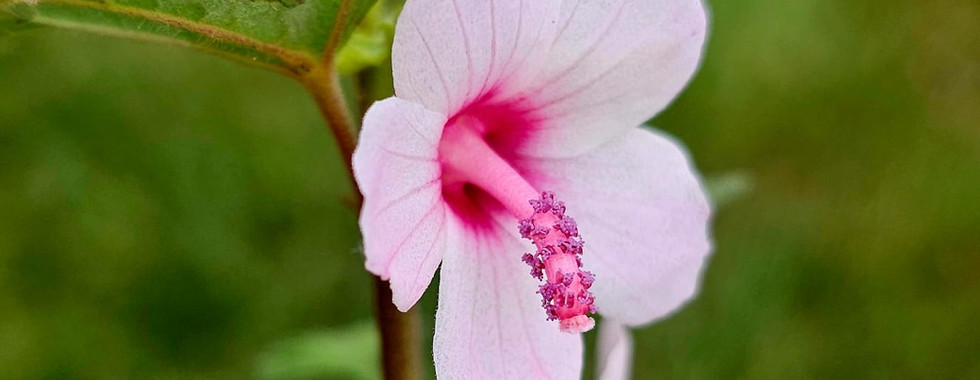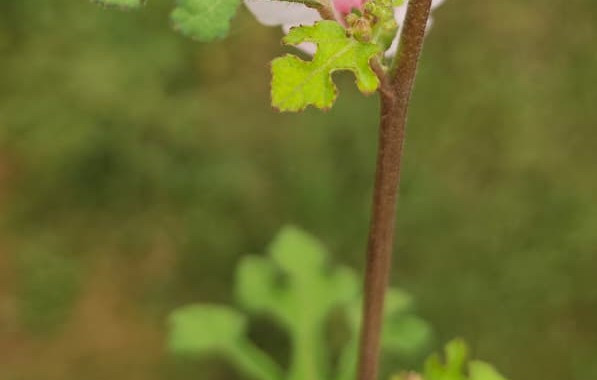Urena lobata (Malvaceae) Caesarweed
- Das K

- Nov 5
- 4 min read
Updated: Nov 6
Urena lobata (Caesarweed)
Taxonomic insights
Species: Urena lobata
Family: Malvaceae
Genus: Urena
Related Herbs from the same family:Sida cordifolia (Bala) - A highly important Ayurvedic Rasayana (rejuvenating) herb, used as a tonic for the nervous system, muscles, and for its anti-inflammatory properties.Hibiscus rosa-sinensis (Shoe Flower, Japa) - A common ornamental plant whose flowers and roots are used in traditional medicine for hair growth, respiratory issues, and as an emmenagogue.Abelmoschus esculentus (Okra, Bhindi) - A common vegetable whose mucilaginous pods share demulcent properties with Urena lobata. The Malvaceae family is rich in mucilage and often exhibits demulcent, emollient, and anti-inflammatory properties.
Common Names:Scientific Name: Urena lobata | English: Caesarweed, Bur Mallow, Congo Jute | Sanskrit: Naagabala, Bala (often used interchangeably with Sida species) | Hindi: Jangli Bhendi, Chikna | Tamil: Ottatti, Vānṭṭi | Telugu: Nalla Benda, Vana Benda | Kannada: Ooratti, Vana Bende | Malayalam: Uṟṟatti, Vana Benda | Marathi: Ran Bhendi, Chikna | Bengali: Bon Kapas | Odia: Bano Bhendo | Assamese: Bon Kapah |
Medicinal UsesAnti-inflammatory, Antipyretic (fever-reducing), Demulcent (soothes irritation), Expectorant, Antirheumatic, Diuretic, Analgesic (pain-relieving), Immunomodulatory, Antioxidant.
Phytochemicals specific to the plant and their action.
Flavonoids: Kaempferol, Quercetin, and their glycosides. These are potent Antioxidants that help scavenge free radicals. They are largely responsible for the plant's significant Anti-inflammatory and Antipyretic activities.
Mucilage Polysaccharides: Found in the leaves and roots. This gelatinous substance is responsible for the Demulcent and Emollient properties, soothing irritated mucous membranes in the throat and digestive tract, and softening the skin.
Phenolic Acids: Vanillic acid, Syringic acid, Ferulic acid. These compounds contribute to the overall Antioxidant capacity and also exhibit Anti-inflammatory and antimicrobial activities.
Sterols: β-sitosterol. This phytosterol has demonstrated Anti-inflammatory and Analgesic (pain-relieving) effects, supporting its use in rheumatic conditions. It may also support immune function.
Tannins: Provide a mild Astringent action, which can be useful in toning tissues and managing minor wounds or diarrhea.
Traditional and Ethnobotanical uses covering the Medicinal uses.
Anti-inflammatory & Antirheumatic (for Joint Pain and Inflammation)
Formulation: Root decoction or paste.
Preparation & Use: A decoction of the root is consumed daily to relieve rheumatic pain and inflammation. A paste made from the leaves or roots is applied topically to swollen joints and painful areas.
Reasoning: The flavonoids (Quercetin, Kaempferol) and β-sitosterol work synergistically to inhibit inflammatory pathways in the body, providing Analgesic and Anti-inflammatory relief.
Antipyretic & Demulcent (for Fevers and Cough)
Formulation: Leaf or root decoction.
Preparation & Use: A decoction is prepared from the leaves or roots and consumed to reduce fever. The same warm decoction is used to relieve dry, irritable coughs and sore throats.
Reasoning: The flavonoids act on the hypothalamus to reduce fever. The Demulcent mucilage coats the throat, relieving irritation and the urge to cough.
Immunomodulatory & Tonic (for Debility and Weakness)
Formulation: Root decoction.
Preparation & Use: Similar to its relative Bala (Sida cordifolia), a decoction of Urena lobata root is used as a general tonic during convalescence, for fatigue, and to support the nervous system.
Reasoning: The combination of antioxidants, sterols, and nutrients helps combat oxidative stress and supports overall vitality, giving it a nutritive and strengthening (Bala-promoting) effect.
Wound Healing & Skin Diseases
Formulation: Leaf poultice or paste.
Preparation & Use: Fresh leaves are crushed into a paste and applied directly to wounds, ulcers, boils, and skin rashes to promote healing and reduce inflammation.
Reasoning: The Anti-inflammatory and Antioxidant compounds reduce swelling and infection, while the mucilage and astringent tannins help form a protective layer and promote tissue contraction.
Culinary uses- Decoction, teas, juices and Healing recipes.
While not a common culinary item, the young leaves are sometimes used as a pot herb in times of scarcity. Its primary use is medicinal.
General Tonic and Anti-inflammatory Decoction
Purpose: To boost energy, reduce inflammation, and support recovery from illness.
Preparation & Use:
Take 5-10 grams of dried Urena lobata root.
Boil in 2 cups of water until it reduces to 1 cup.
Strain the decoction.
Consume 15-30 ml of this decoction twice a day.
Soothing Cough Syrup
Purpose: To relieve dry cough and sore throat.
Preparation & Use:
Prepare a root decoction as above.
Mix 1 part of this decoction with 1 part of raw honey.
Take 1-2 teaspoons of this syrup 3-4 times a day as needed.
Healing Leaf Poultice for Boils and Sprains
Purpose: To draw out toxins from boils and reduce swelling from sprains.
Preparation & Use:
Take a handful of fresh Urena lobata leaves.
Warm them slightly and crush thoroughly to make a sticky paste.
Apply the paste directly to the affected area.
Cover with a clean cloth and leave on for a few hours. Reapply 2-3 times a day.
Disclaimer:Urena lobata is generally considered safe when used in traditional preparations. However, scientific data on its long-term safety is limited. Due to its potential effects on the immune system and inflammation, individuals with autoimmune diseases or those on immunosuppressant medications should use it with caution and only after consulting a healthcare provider. Pregnant and lactating women should avoid its medicinal use due to a lack of safety data. This information is for educational purposes only and is not medical advice.
Reference Books, Books for In-depth Study:
Indian Medicinal Plants by K.S. Kiritkar and B.D. Basu
The Ayurvedic Pharmacopoeia of India
Ethnobotany of India Series
Further study:Plants that might interest you due to similar medicinal properties
Bala (Sida cordifolia), Family: Malvaceae. This is its most important botanical relative in Ayurveda. Both are named Bala (meaning "strength") and are used as rejuvenating tonics for debility, nervous disorders, and rheumatic conditions, sharing demulcent and anti-inflammatory properties.
Marshmallow (Althaea officinalis), Family: Malvaceae. A Western herb from the same family, it is the quintessential demulcent plant. It shares the high mucilage content of Urena lobata and is used almost identically for soothing coughs, sore throats, and digestive irritation.
Country Mallow (Abutilon indicum - Atibala), Family: Malvaceae. Another close relative used in Ayurveda, often paired with Sida cordifolia (Bala). It shares similar tonic, demulcent, and anti-inflammatory uses, reinforcing the medicinal themes of the Malvaceae family.















Comments